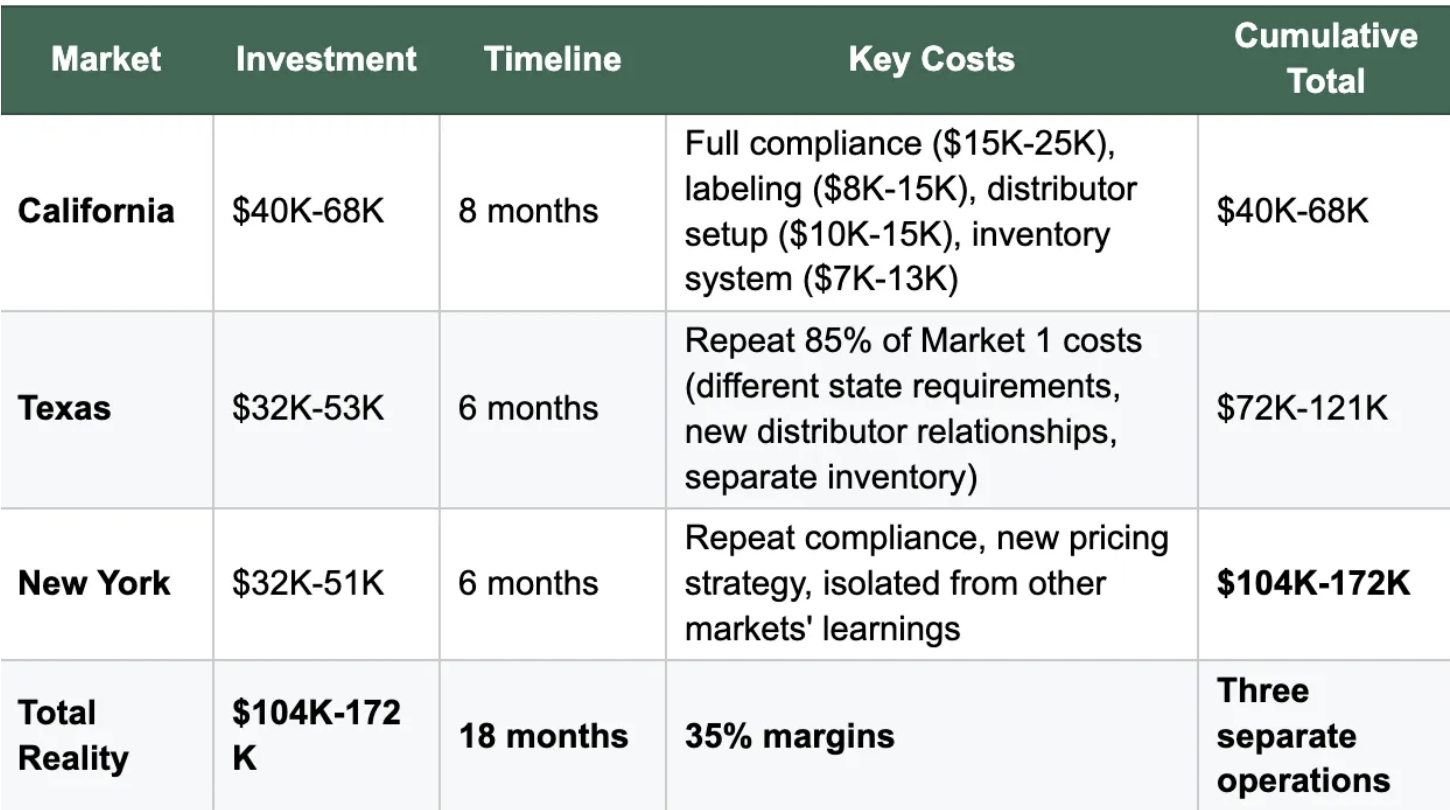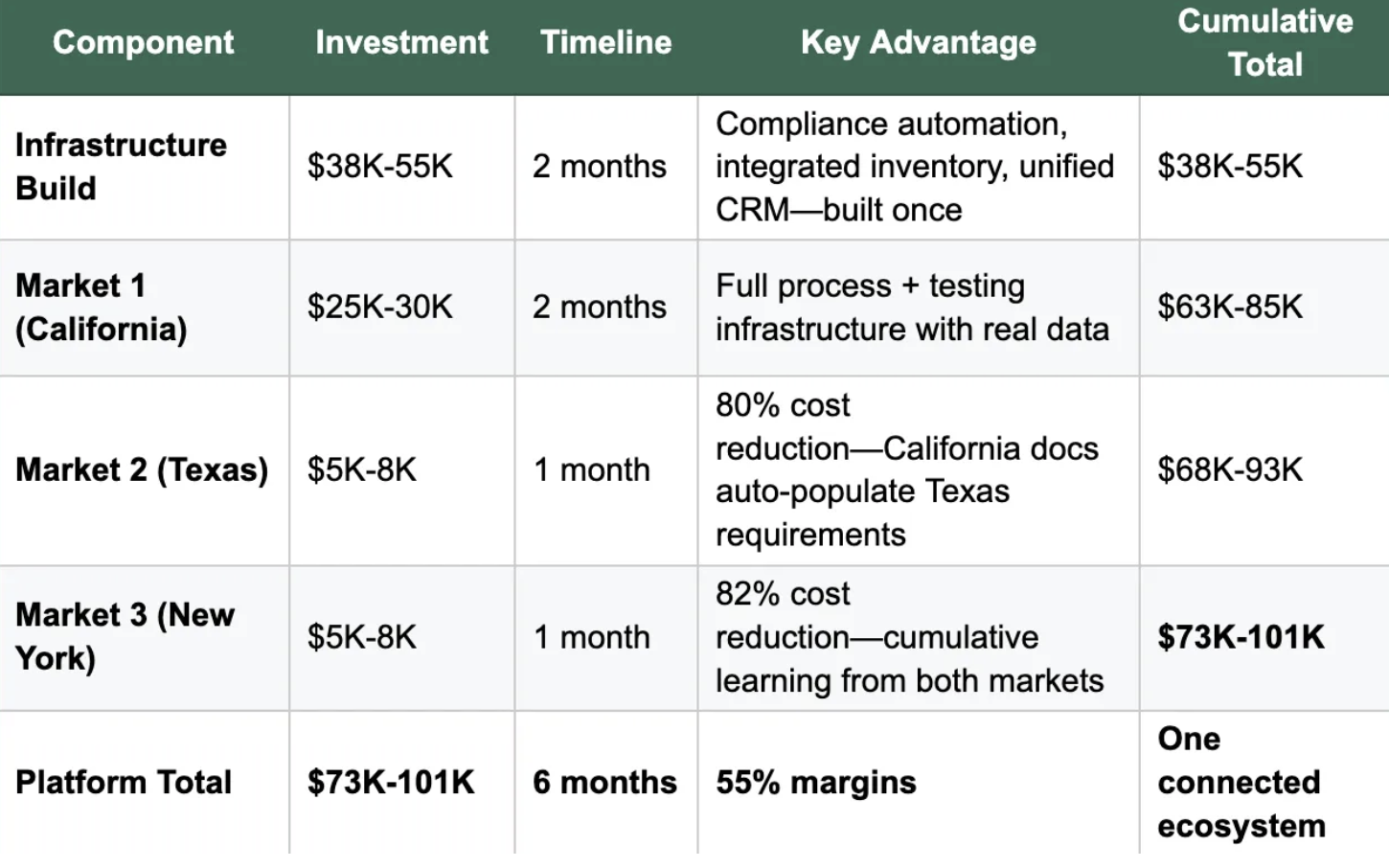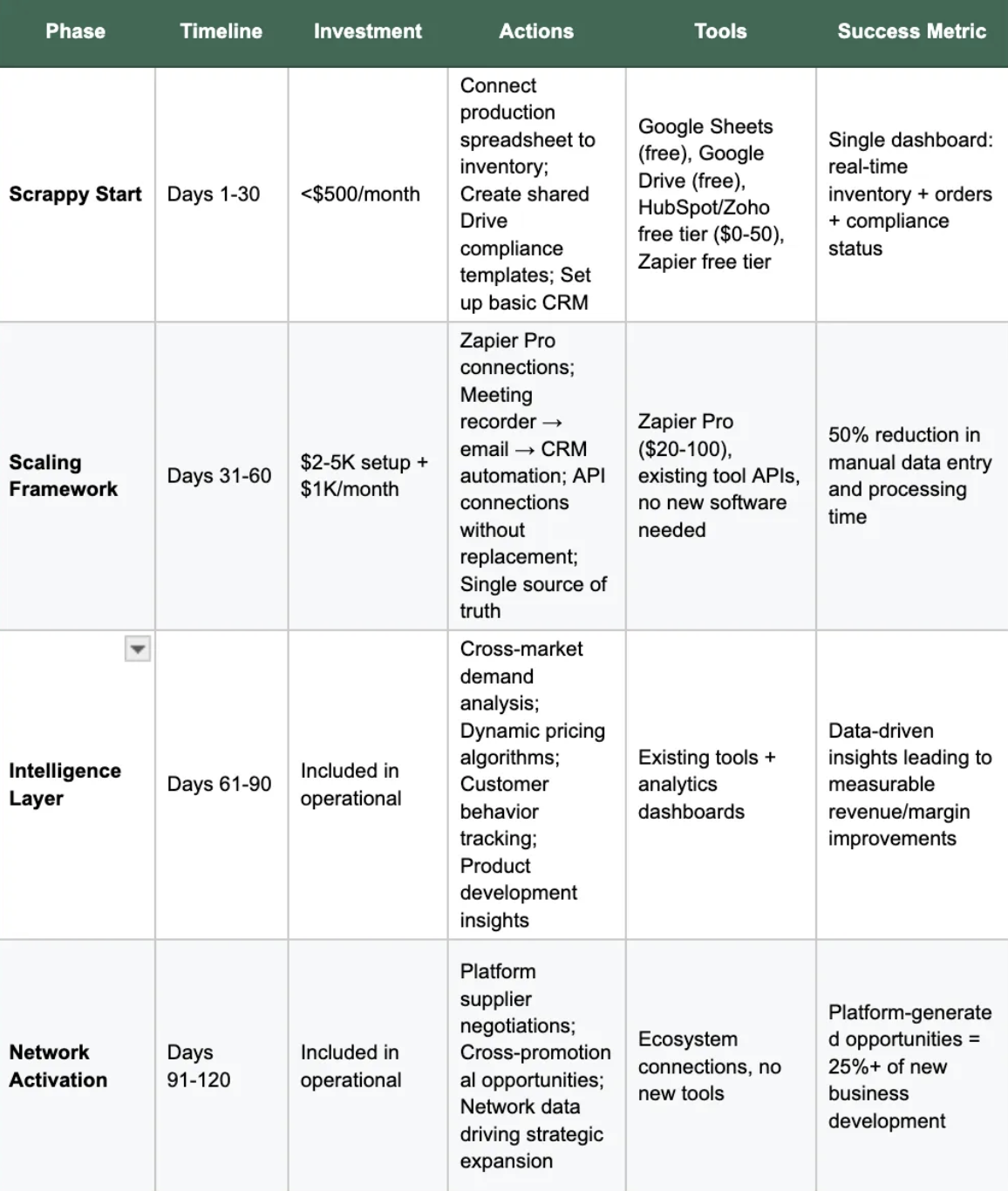This blog is also available on Substack. Follow along there for addition insights into the artisanal spirits sector and supply chain technology.
Earlier this month I spent 15 minutes at Bar Convent Berlin telling a room full of brand owners, distributors, and industry experts that they’re thinking about their businesses wrong.
Not because their products aren’t great. Not because their marketing is off. Not because they’re choosing the wrong markets.
Because they’re still thinking like product companies when they need to be thinking like platform businesses.
And judging by the crowd that mobbed me afterward with questions—many looking equal parts excited and terrified—this message hit hard.
Let me share what I told them, and more importantly, why it matters for your brand.
The $200,000 Mistake Everyone’s Making
I opened with a story that’s happening right now to someone reading this.
Sarah (composite of dozens of conversations I’ve had) launched a premium gin in three markets simultaneously. California, Texas, and New York. Great product. Strong branding. Solid distribution relationships.
Here’s what it actually cost her:
Table 1: The Traditional Multi-Market Launch Economics

What killed her wasn’t the money—it was the structure:
- California compliance documentation lost when Texas launch started
- Customer insights from California trapped in distributor’s system
- Texas supply chain lessons never made it to New York team
- Each market repeated the same mistakes
- No shared infrastructure meant no learning compounding
She paid $67,000 per market and got three disconnected operations that couldn’t talk to each other.
Now here’s the platform approach for the exact same three-market launch:

The difference: $31K-71K savings (30-41%), 12 months faster (67%), 20-point margin improvement.
But here’s what the numbers don’t show: Sarah’s still hunting for California compliance documents 8 months later. The platform brand? Launching market four next month for $6,000 because the infrastructure already exists.
That’s not theory. That’s the math of platform thinking.
What Platform Thinking Actually Means (And Where It Came From)
Platform thinking didn’t start in the spirits industry. It came from companies that figured out something fundamental about value creation.
Amazon isn’t a retailer. It’s a platform connecting buyers, sellers, logistics providers, and developers. Each new seller makes the platform more attractive to buyers. Each new buyer attracts more sellers. The flywheel spins faster—that’s network effects.
Uber doesn’t own cars. It’s a platform connecting drivers and riders. More drivers mean shorter wait times. Shorter wait times mean more riders. More riders mean better earnings for drivers. Value compounds exponentially.
Your brand is already a platform.
You’re already connecting:
- Production forecasting to inventory management
- Compliance requirements to distribution networks
- Customer feedback to product development
- Market intelligence to strategic decisions
- Supplier relationships to procurement optimization
The question isn’t whether you’re a platform.
The question is whether you’re managing those connections strategically or accidentally.
Network effects research from South Korea’s food delivery platforms proves this: A 10% increase in consumers triggered a 15% increase in restaurant adoption. That’s the platform multiplier effect. More participants make the system exponentially more valuable for everyone.
In spirits? More producers attract more buyers. More buyers attract more producers. But only if the connections work.
The Three Pillars of Connected Brand Infrastructure
I’ve developed three pillars of thinking that should serve as the foundation of this approach:
Pillar 1: Production Intelligence & Procurement Optimization
What it means: Your production data doesn’t just track what you made—it becomes procurement intelligence that reduces costs and improves quality.
Real transformation: CVH Spirits (Whisky)
When CVH Spirits became independent in 2023 after the Heineken-Distell acquisition, they inherited systems designed for “high volume, high market share, lots of distribution points.” Completely wrong for premium, scattered, customer-focused brands like Bunnahabhain, Deanston, and Tobermory.
They had 4 months to build platform infrastructure from scratch.
What they connected:
- Production-line capacity planning across distilleries
- Intercompany stock transfers and procurement
- Warehouse capacity planning at multiple sites
- Demand forecasting unified across all geographies
Measured results in 4 months:
- 20% forecast accuracy improvement (on track to target)
- More stable production planning
- 15-25% lower stock volumes without reducing customer service
- Full end-to-end supply chain transparency
- Improved procurement confidence driving better purchase strategy
The magic isn’t the platform—it’s that production data automatically becomes procurement intelligence across their entire portfolio.
Pillar 2: Compliance & Distribution Platform
What it means: Stop starting from zero every time. Create reusable compliance infrastructure that scales effortlessly.
This hit hardest at BCB because everyone’s lived it. You file California compliance. Eight months later, you’re launching in Texas and can’t find the California paperwork. You’re rebuilding from scratch.
Here’s what platform brands do differently:
They build documentation systems once for California. That same system automatically populates Texas requirements. And EU submissions. And wherever they expand next.
Our own data at Maguey Exchange: We’ve reduced compliance processing from 6 months to 3 weeks—an 83% reduction—by building reusable infrastructure. When a producer launches their second market, we’re not starting over. We’re reusing 80% of the work.
Industry benchmark from Suntory Global Spirits: They implemented supply chain visibility platforms and achieved 99% demurrage fee reduction within 6 months. That’s hundreds of thousands in direct savings from connected systems eliminating manual coordination failures.
The result: 6 months becomes 3-4 weeks for market entry. 80% compliance cost reduction for additional markets.
You’re not rebuilding the wheel. You’re reusing infrastructure. And every market gets easier, not harder.
Pillar 3: Customer & Market Intelligence Platform
What it means: Stop learning lessons twice. Transform customer data into cross-market insights that drive strategic decisions.
Real transformation: Micil Distillery (Irish Whiskey)
Micil Distillery had a great product and strong brand identity. But their digital presence was disconnected from their craft story. They were missing direct-to-consumer opportunities because systems didn’t talk to each other.
They implemented connected e-commerce infrastructure:
- Visual brand integration across touchpoints
- Scalable platform ready for new product launches
- High-traffic stability infrastructure
- Data insights capabilities informing business decisions
- Foundation for digital marketing initiatives
The result: 400% online sales increase immediately after launch.
Not 6 months later. Not after optimization. Immediately. They literally quadrupled digital revenue overnight because connected systems eliminated friction between brand story, customer experience, and transaction capability.
That’s what platform thinking delivers. California customer preferences for cocktail-focused products instantly inform New York bar strategy. Market feedback loops directly into product development. You’re not repeating mistakes—you’re compounding learning.
Each connection multiplies value. That’s exponential returns, not linear.
Academic research on platform economics proves this through Metcalfe’s Law: Network value grows as n² (square of participants). Two connected markets create 4x value. Five connected markets? 25x value. Platform advantages compound.
The Platform Economics Framework
Let me show you what this actually delivers to your P&L across five measurable dimensions:
Table 2: The Five Platform Multipliers

Platform ROI Logic: Each connected system makes every other system more valuable, creating exponential rather than linear returns.
Investment Framework: $15-35K infrastructure investment typically generates 200-400% first-year ROI through efficiency gains alone—before considering growth acceleration, new market revenue, or prevented mistakes.
Real numbers from digital transformation studies:
- Drinkubator spirits clients: 75% marketing budget savings in Year 1 through connected systems
- Food & beverage automation: 350% capacity improvement post-implementation
- Pernod Ricard (Jameson): 40% media ROI increase through digital transformation
This isn’t aspirational. These are verified, documented results from brands that made the shift.
Case Study: Two Connected Brand Transformations
Let me show you what this looks like across different spirits categories with different challenges:
CVH Spirits: Premium Whisky Portfolio Platform
The Challenge: Inherited subsidiary systems designed for mass market when they needed premium, scattered, customer-focused infrastructure. Had 4 months to transform or fail.
Platform Transformation: Connected production planning, procurement, warehouse operations, and demand forecasting into unified Anaplan platform across Taiwan operations and third-party sites.
Measured Outcomes:
- Revenue Impact: More stable production planning enabling confident growth
- Margin Impact: 15-25% lower stock without service reduction
- Operational Impact: 20% forecast accuracy improvement in 4 months
- Strategic Impact: Full supply chain transparency driving better purchase decisions
Timeline: 4-month complete transformation
Daryl Gobey, Demand Planning Manager: “We targeted a 20% increase in forecast accuracy after implementing Anaplan, and we’re on track to achieve that. This means we have a more stable production plan and lower stock volumes without reducing customer service.”
Micil Distillery: Heritage Brand Digital Commerce Platform
The Challenge: Award-winning craft distillery with strong brand identity but digital presence didn’t reflect craftsmanship quality. Missing direct-to-consumer revenue.
Platform Transformation: Built WordPress + WooCommerce infrastructure with visual brand integration, scalable for new launches, high-traffic stability, and data insights capabilities.
Measured Outcomes:
- Revenue Impact: 400% online sales increase immediately
- Market Impact: Quadrupled digital revenue overnight
- Strategic Impact: Established benchmark for craft spirits digital presence
- Growth Impact: Platform positioned for international expansion
Timeline: Immediate results upon launch
Brand owner testimonial: “They went above and beyond, and the result is an incredible website that has literally quadrupled our online sales overnight, and given our company an online brand home that we can be proud of.”
What changed in both cases? Not the products. Not the teams. Not the markets.
They stopped managing isolated pieces and started building connected ecosystems. CVH connected production to procurement to forecasting. Micil connected brand story to customer experience to transaction capability.
That’s platform thinking. And that’s why the results are measurable and immediate.
The Practical Implementation Path
The objection I heard most at BCB: “This sounds expensive and complicated.”
Actually, you can start for under $500/month. Here’s the exact framework:
Table 3: The 120-Day Platform Implementation Framework

Critical insight: Services like Zapier are your friend. My meeting recorder connects to my email which connects to my CRM. I’m not doing anything manually. That’s three systems talking to each other for $30/month.
Total Investment Over 120 Days: $15K-35K Typical First-Year ROI: 200-400% Payback Period: 4-12 months Ongoing Monthly Cost: $1K-2K (less than one distributor dinner budget)
Tool-Agnostic Philosophy: Use what you have. Shopify → NetSuite → HubSpot → Avalara. Whatever works for your business. Focus on data flow, not specific platforms. Build for flexibility, not vendor lock-in.
You don’t need massive upfront investment. You need strategic connection.
The brands worried about cost should calculate what they’re currently spending on the fragmentation tax: 15-20 hours per month hunting for documents, manually copying data, recreating work. That’s $75K-190K annually for brands doing $2-5M in revenue.
Platform infrastructure eliminates 80% of that waste in 120 days.
The Competitive Moat Platform Brands Are Building
Here’s why this matters strategically—and why I’m seeing early movers gain insurmountable advantages:
Year 1 Platform Advantage:
- 30% operational efficiency gain
- 50% faster market entry (3 markets vs. 1 for traditional brands)
- Basic network effects activating
- Data collection beginning
Year 2 Cumulative Advantage:
- 50% operational efficiency (compounding from Year 1)
- 5-6 markets vs. competitors’ 2-3
- Network effects: According to Metcalfe’s Law, 5 connected markets = 25x value vs. competitors’ 2 markets = 4x value
- Two years of cross-market intelligence vs. competitors’ isolated learnings
- Cost structure: 40% lower than traditional approach
Year 3 Insurmountable Lead:
- 70% operational efficiency
- 8-10 markets vs. competitors’ 3-4
- Network effects: 64-100x value vs. competitors’ 9-16x
- Three years of compounded learning
- Cost structure: 60-70% lower than competitors
- Self-sustaining network growth
- Competitors would need $500K-2M and 2-3 years to catch up—to a moving target
This isn’t theory. Research on platform dominance shows consistent patterns: 80% of value gets captured by the top 20% of participants in platform markets. Winner-take-most dynamics are real.
I’m watching this happen in real-time. The brands building infrastructure now are creating moats that will be unbridgeable in 18 months.
The Three Positions: Where Do You Stand?
After my presentation, I broke down the strategic reality. Look around your own market:
Early Movers (Currently 10% of Brands):
Building network effects right now while market fragments. Capturing exponential value while competitors watch. Connected systems creating competitive moats.
In 18 months, they’ll be untouchable. They’ll have 8-10 markets, 70% operational efficiency, and network effects worth 64-100x compared to traditional brands’ 9-16x.
What they’re doing now:
- Implementing platform infrastructure (4-6 months)
- Activating network effects across markets
- Capturing market share through superior economics
- Building data moats competitors can’t replicate
Fast Followers (Currently 60% of Brands):
Implementing proven frameworks for competitive parity. They’ll survive, they’ll compete. They won’t lead, but they won’t die.
They have 6-12 months to make this move. After that, the gap becomes unbridgeable.
What they need to do:
- Study early mover playbooks (like CVH and Micil)
- Implement 120-day framework immediately
- Achieve operational parity before moats solidify
- Accept they won’t be category leaders but can be profitable
Laggards (Currently 30% of Brands):
Still operating with 1995 infrastructure in 2025. Managing 15 disconnected systems. Hunting for compliance documents. Manually copying data. Learning lessons twice.
In 24 months, they’ll be:
- Paying premium prices to access others’ platform infrastructure
- Margin-squeezed middle players unable to compete on economics
- Acquisition targets or failure candidates
- Their window is closing fast
The brutal reality: Industry research shows platform markets exhibit power law distribution. The top 20% capture 80% of value. If you’re not building infrastructure now, you’re choosing which 80% you’ll be in.
What Keeps Me Up at Night
I talk to brand owners every week. Great products. Passionate people. Strong brands.
But they’re building 1995 infrastructure in 2025.
They’re spending 15-20 hours per month on manual bullshit:
- Hunting for compliance documents: 3-4 hours per market expansion
- Manually updating inventory across spreadsheets: 2-3 hours per week
- Copying customer data from distributor reports: 1-2 hours per week
- Recreating compliance paperwork for different states: 5-8 hours per new market
- Learning the same lessons twice because insights don’t transfer between markets
That’s not operations. That’s a $75K-190K annual fragmentation tax.
And they’re wondering why platform brands are eating their lunch.
Meanwhile, CVH Spirits transformed their entire portfolio in 4 months. Micil Distillery quadrupled sales overnight. Platform brands are moving at 5x the speed while spending 60% less.
The gap is widening every month.
Your Platform Journey Starts With Four Steps
I closed my BCB presentation with action, not inspiration:
1. Mindset Shift: Think Ecosystem, Not Product
This is the hardest part. Everything else follows. Your brand isn’t a bottle. It’s a network of connections creating value. You’re already connecting production to inventory to compliance to distribution to customers. The question is whether those connections work for you or against you.
2. Infrastructure Audit: Map Current Systems
Spend two hours this week. List every system you use. Every manual handoff. Every time you copy data from one place to another. Every time you hunt for a document. Every time you learn something in one market that doesn’t make it to another market.
You probably have 80% of what you need. You just need to connect it.
3. Pilot Implementation: Choose One High-Impact Integration
Pick one. Not three. One.
Usually compliance or customer data. The one that hurts the most. The one where you spend the most time hunting for information or manually moving data.
Do it right. Prove the value. Two hours of setup saves 10+ hours per month forever. That’s 5x ROI in month one.
4. Scale Systematically: Build Network Effects
Once you prove one connection works, you’ll see three more opportunities immediately. Month by month. Connection by connection. Competitive advantage compounds.
CVH did this in 4 months. You can do it in 120 days. Start today.
The Choice You’re Making Today
Every brand already connects producers, distributors, and customers. You’re doing this today.
The question: Are you managing those connections strategically or letting competitors build better systems while you stay fragmented?
The choice isn’t between product and platform thinking.
It’s between building your connected ecosystem now or watching platform brands capture the value you’re creating while you pay premium prices to access their infrastructure.
Here’s what the data shows unambiguously:
- CVH Spirits: 4 months, 20% forecast accuracy, complete transformation
- Micil Distillery: 400% sales increase, immediate results, quadrupled revenue
- Suntory Global Spirits: 99% demurrage reduction in 6 months
- Platform economics research: Network value grows as n² (Metcalfe’s Law)
- Market trajectory: $48.9B → $125.7B by 2029 (26.6% CAGR)
- Winner dynamics: Top 20% captures 80% of value in platform markets
The brands building this today will have exponential advantages over those waiting for transformation to happen to them.
That transformation is happening whether you participate or not.
The craft spirits market will hit $125.7 billion by 2029. The question is whether you’ll be among the 10% building platforms that capture disproportionate value, the 60% implementing fast enough to survive, or the 30% paying platform premiums until you’re acquired.
Your window to choose is 6-12 months. After that, the moats become unbridgeable.


